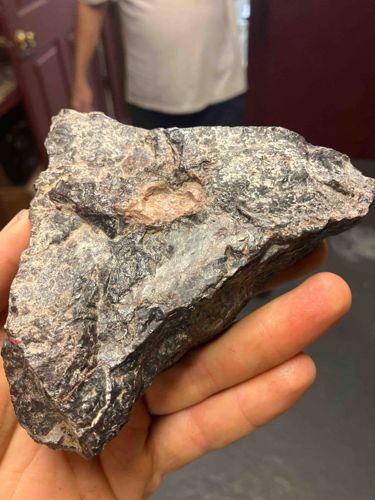
Unidentified Rock or Mineral Specimen
This appears to be a rock or mineral specimen, roughly triangular or parallelogram-shaped in outline, held in an individual's hand. Its estimated dimensions, based on its relative size to the hand, would be approximately 4-6 inches in its longest dimension. The primary color is a dark, mottled grey to black, suggesting a darker mineral composition, possibly basalt, schist, or an iron-rich rock. There are significant areas of lighter grey and reddish-brown coloration, especially a prominent light brown/pinkish inclusion near the center of the visible face, which has a coarser, more granular texture compared to the surrounding darker matrix. This inclusion could be a different mineral vein, a weathered patch, or a distinct rock type within the specimen. The surface is highly irregular and fractured, displaying a rough, uneven texture with numerous visible cleavage planes, fissures, and sharp edges. There are no obvious signs of polishing, shaping, or human modification; it appears to be a natural formation. Some areas exhibit a slightly lustrous or crystalline appearance when light catches them, suggesting the presence of certain minerals. There are no discernible maker's marks, signatures, or stamps. The overall condition suggests natural weathering and fracturing, with no visible signs of recent damage or repair. The specimen does not appear to be of a distinct artistic or manufactured style, making its age pre-historic or geological in nature. Its primary value would lie in its geological or mineralogical interest.
AI-Generated Appraisal Disclaimer
Estimated Value
$10-25
Basic Information
Category
Geological Specimen
Appraised On
November 27, 2025
Estimated Value
$10-25
Item Description
This appears to be a rock or mineral specimen, roughly triangular or parallelogram-shaped in outline, held in an individual's hand. Its estimated dimensions, based on its relative size to the hand, would be approximately 4-6 inches in its longest dimension. The primary color is a dark, mottled grey to black, suggesting a darker mineral composition, possibly basalt, schist, or an iron-rich rock. There are significant areas of lighter grey and reddish-brown coloration, especially a prominent light brown/pinkish inclusion near the center of the visible face, which has a coarser, more granular texture compared to the surrounding darker matrix. This inclusion could be a different mineral vein, a weathered patch, or a distinct rock type within the specimen. The surface is highly irregular and fractured, displaying a rough, uneven texture with numerous visible cleavage planes, fissures, and sharp edges. There are no obvious signs of polishing, shaping, or human modification; it appears to be a natural formation. Some areas exhibit a slightly lustrous or crystalline appearance when light catches them, suggesting the presence of certain minerals. There are no discernible maker's marks, signatures, or stamps. The overall condition suggests natural weathering and fracturing, with no visible signs of recent damage or repair. The specimen does not appear to be of a distinct artistic or manufactured style, making its age pre-historic or geological in nature. Its primary value would lie in its geological or mineralogical interest.
Get Your Items Appraised
Instant estimates of your treasures with AI-powered instant appraisals